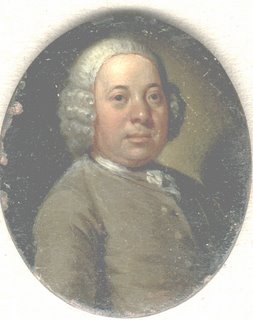
This unsigned miniature portrait is oil on copper. Although included under British, it may be European. 328
A kind visitor has since left a comment wondering if it is by Cornelius Troost (1697-1750). Troost has been called "the Hogarth Hollandais" and the Watteau Hollandais", and of him the following has been written;
Cornelis Troost, the son of a goldsmith, first chose a profession as an actor, performing at the Amsterdam Theatre, c. 1717-24. His wife's family were theatre people, while his own family were artists. One of Troost's earliest works was his infamous drawing of 'Prince Eugene of Savoy in the brothel of Madame Teresa on Prinsengracht.' The prince was Austrian governor of the The Netherlands at the time. (‘Prins Eugenius van Savoye in het etablissement van Madame Traese op de Prinsengracht te Amsterdam,' Cornelis Troost (ca. 1720) Rijksmuseum, Amsterdam.)
Beginning in 1723 Troost studied under the eminent portrait painter, Arnold Boonen (1669-1729) and was, himself, initially predominately a portraitist. Finding quick success, by 1724, he received a commission for a life-size group portrait of 'The Inspectors of Collegium Medicum,' now in the Rijksmuseum, Amsterdam. The success of this work led to many other large works, though few survive intact. (Ref. 'Dutch Painting, 1600-1800,' Prof. Seymour Slive, The Yale University Press)
Troost never abandoned his thespian connections. From 1732, he produced a number of acclaimed depictions of theatrical scenes, as well as painting a number of stage sets for his old theatre, though none of the latter are known to survive. (Ref. J.W. Niemeijer, Cornelis Troost 1696-1750, Assen, 1973.) His study for Molière's 'Le Malade Imaginaire' was auctioned by Christie's in 2004, bringing £43,020 ($78,985).
Troost was also lauded for his conversation pieces and genre scenes. His best known work, his 'NELRI' series (1739-40), exhibited at Mauritshuis, The Hague, portrays a group of young bachelors at a reunion, beginning with a quiet evening, eventually ending with a scene long after midnight, in which the young men are all very drunk: a humorous work skillfully showing the emotional and physiological stages of inebriation. Sometimes Troost is referred to as the Dutch Hogarth, though his work never moralizes, emphasizing instead the humor of situations.
Fuchs describes Troost as "by far the most original and versatile artist of his age" (Fuchs, RH, 'Dutch painting,' 1978, Thames and Hudson, London, p. 144). A luscious self portrait by Troost may be seen by Googling 'Troost Self Rijksmuseum.' While there, take a look at his other works at that museum. Others may be seen in The Royal Picture Gallery at the Mauritshuis in Den Haag.
Examples of miniatures by Troost appear to be uncommon, although he is listed in Blattel.
1 comment:
I wonder if it is by the artist Cornelis Troost.
Post a Comment